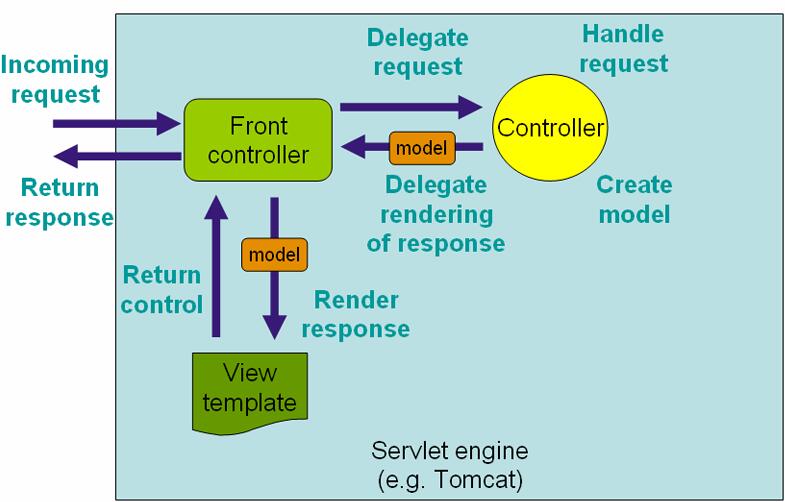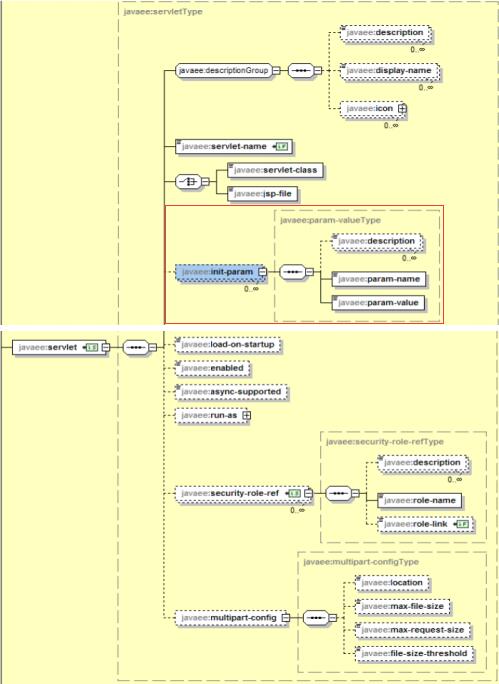Spring framework MVC源码阅读笔记(一)
2016-09-14 16:45
525 查看
org.springframework.web.servlet.DispatcherServlet
下图来自Spring官方文档,MVC对请求的处理流程

上图中Front controller由DispatcherServlet充当,负责拦截和响应请求。实际请求的处理和响应的生成由Controller完成,这里的Controller具体就是平时用@Controller注解配置的类,这些类中由@RequestMapping配置的方法对应Handler,Spring MVC提供了HandlerMapping接口用于保存请求与Handler之间的对应的关系,请求最终会交给最匹配的Handler来处理。(View template部分暂缺,还说不清)
下图为DispatcherServlet继承结构

该类根据配置拦截请求,从图片和类名可知该类就是是一个Servlet,那么普通的Servlet所用有的特性该类自然也有。
下图为Servlet配置信息,该信息来自Servlet规范(该文档非常值得一看)

先看DispatcherServlet的一般配置
该类由容器负责实例化,load-on-startup为1应该是在容器启动是就加载该类。Servlet配置信息比较关注init-param节点,该节点可以为Servlet提供一些参数,通过复写init方法可以获得,DispatcherServlet的属性也是通过这个方式配置的,其具体实现在祖先类HttpServletBean中找到,不过之前平时使用时从来没配过。
自定义的Servlet通常会继承javax.servlet.http.HttpServlet然后根据需要复写不同的方法,DispatcherServlet只复写了doService方法,其他的都交由祖先类处理。
以下是doService的具体实现
DispatcherServlet中维护了一个(或不止一个Map)用于保存处理者和请求之间的对于关系,从中获取最匹配的Handler来处理请求,如果找不到大概就会返回404的错误。以下为挑选Handler及实际处理请求实现:
未完,待续……
下图来自Spring官方文档,MVC对请求的处理流程

上图中Front controller由DispatcherServlet充当,负责拦截和响应请求。实际请求的处理和响应的生成由Controller完成,这里的Controller具体就是平时用@Controller注解配置的类,这些类中由@RequestMapping配置的方法对应Handler,Spring MVC提供了HandlerMapping接口用于保存请求与Handler之间的对应的关系,请求最终会交给最匹配的Handler来处理。(View template部分暂缺,还说不清)
下图为DispatcherServlet继承结构

该类根据配置拦截请求,从图片和类名可知该类就是是一个Servlet,那么普通的Servlet所用有的特性该类自然也有。
下图为Servlet配置信息,该信息来自Servlet规范(该文档非常值得一看)

先看DispatcherServlet的一般配置
<web-app> <servlet> <servlet-name>example</servlet-name> <servlet-class>org.springframework.web.servlet.DispatcherServlet</servlet-class> <load-on-startup>1</load-on-startup> </servlet> <servlet-mapping> <servlet-name>example</servlet-name> <url-pattern>/example/*</url-pattern> </servlet-mapping> </web-app>
该类由容器负责实例化,load-on-startup为1应该是在容器启动是就加载该类。Servlet配置信息比较关注init-param节点,该节点可以为Servlet提供一些参数,通过复写init方法可以获得,DispatcherServlet的属性也是通过这个方式配置的,其具体实现在祖先类HttpServletBean中找到,不过之前平时使用时从来没配过。
自定义的Servlet通常会继承javax.servlet.http.HttpServlet然后根据需要复写不同的方法,DispatcherServlet只复写了doService方法,其他的都交由祖先类处理。
以下是doService的具体实现
@Override
protected void doService(HttpServletRequest request, HttpServletResponse response) throws Exception {
if (logger.isDebugEnabled()) {
String resumed = WebAsyncUtils.getAsyncManager(request).hasConcurrentResult() ? " resumed" : "";
logger.debug("DispatcherServlet with name '" + getServletName() + "'" + resumed +
" processing " + request.getMethod() + " request for [" + getRequestUri(request) + "]");
}
// Keep a snapshot of the request attributes in case of an include,
// to be able to restore the original attributes after the include.
//总而言之先保存下request携带的属性,从代码可以看出只保留了MVC相关的属性
Map<String, Object> attributesSnapshot = null;
if (WebUtils.isIncludeRequest(request)) {
attributesSnapshot = new HashMap<>();
Enumeration<?> attrNames = request.getAttributeNames();
while (attrNames.hasMoreElements()) {
String attrName = (String) attrNames.nextElement();
if (this.cleanupAfterInclude || attrName.startsWith("org.springframework.web.servlet")) {
attributesSnapshot.put(attrName, request.getAttribute(attrName));
}
}
}
// Make framework objects available to handlers and view objects.
//为request添加一些属性,在真正负责处理请求的代码使用(?)
request.setAttribute(WEB_APPLICATION_CONTEXT_ATTRIBUTE, getWebApplicationContext());
request.setAttribute(LOCALE_RESOLVER_ATTRIBUTE, this.localeResolver);
request.setAttribute(THEME_RESOLVER_ATTRIBUTE, this.themeResolver);
request.setAttribute(THEME_SOURCE_ATTRIBUTE, getThemeSource());
//Flash相关,暂时不管
FlashMap inputFlashMap = this.flashMapManager.retrieveAndUpdate(request, response);
if (inputFlashMap != null) {
request.setAttribute(INPUT_FLASH_MAP_ATTRIBUTE, Collections.unmodifiableMap(inputFlashMap));
}
request.setAttribute(OUTPUT_FLASH_MAP_ATTRIBUTE, new FlashMap());
request.setAttribute(FLASH_MAP_MANAGER_ATTRIBUTE, this.flashMapManager);
try {
//实际转发请求的代码
doDispatch(request, response);
}
finally {
if (!WebAsyncUtils.getAsyncManager(request).isConcurrentHandlingStarted()) {
// Restore the original attribute snapshot, in case of an include.
if (attributesSnapshot != null) {
restoreAttributesAfterInclude(request, attributesSnapshot);
}
}
}
}DispatcherServlet中维护了一个(或不止一个Map)用于保存处理者和请求之间的对于关系,从中获取最匹配的Handler来处理请求,如果找不到大概就会返回404的错误。以下为挑选Handler及实际处理请求实现:
protected void doDispatch(HttpServletRequest request, HttpServletResponse response) throws Exception {
HttpServletRequest processedRequest = request;
HandlerExecutionChain mappedHandler = null;
boolean multipartRequestParsed = false;
//看字面意思,为处理异步请求做准备,到目前为止没怎么用过异步Servlet
WebAsyncManager asyncManager = WebAsyncUtils.getAsyncManager(request);
try {
ModelAndView mv = null;
Exception dispatchException = null;
try {
//是否为上传文件的请求,是的话先处理下
processedRequest = checkMultipart(request);
multipartRequestParsed = (processedRequest != request);
// Determine handler for the current request.
//选择具体的Handler
mappedHandler = getHandler(processedRequest);
if (mappedHandler == null || mappedHandler.getHandler() == null) {
noHandlerFound(processedRequest, response);
return;
}
// Determine handler adapter for the current request.
HandlerAdapter ha = getHandlerAdapter(mappedHandler.getHandler());
// Process last-modified header, if supported by the handler.
//关于HTTP协议中缓存的部分,对于动态生成的内容使用缓存不熟
String method = request.getMethod();
boolean isGet = "GET".equals(method);
if (isGet || "HEAD".equals(method)) {
long lastModified = ha.getLastModified(request, mappedHandler.getHandler());
if (logger.isDebugEnabled()) {
logger.debug("Last-Modified value for [" + getRequestUri(request) + "] is: " + lastModified);
}
if (new ServletWebRequest(request, response).checkNotModified(lastModified) && isGet) {
return;
}
}
if (!mappedHandler.applyPreHandle(processedRequest, response)) {
return;
}
// Actually invoke the handler.
mv = ha.handle(processedRequest, response, mappedHandler.getHandler());
if (asyncManager.isConcurrentHandlingStarted()) {
return;
}
applyDefaultViewName(processedRequest, mv);
mappedHandler.applyPostHandle(processedRequest, response, mv);
}
catch (Exception ex) {
dispatchException = ex;
}
catch (Throwable err) {
// As of 4.3, we're processing Errors thrown from handler methods as well,
// making them available for @ExceptionHandler methods and other scenarios.
dispatchException = new NestedServletException("Handler dispatch failed", err);
}
processDispatchResult(processedRequest, response, mappedHandler, mv, dispatchException);
}
catch (Exception ex) {
triggerAfterCompletion(processedRequest, response, mappedHandler, ex);
}
catch (Throwable err) {
triggerAfterCompletion(processedRequest, response, mappedHandler,
new NestedServletException("Handler processing failed", err));
}
finally {
if (asyncManager.isConcurrentHandlingStarted()) {
// Instead of postHandle and afterCompletion
if (mappedHandler != null) {
mappedHandler.applyAfterConcurrentHandlingStarted(processedRequest, response);
}
}
else {
// Clean up any resources used by a multipart request.
if (multipartRequestParsed) {
cleanupMultipart(processedRequest);
}
}
}
}//逻辑不复杂,就是从Map中获取Handler,至于该Map是如何维护的还要再看
protected HandlerExecutionChain getHandler(HttpServletRequest request) throws Exception {
for (HandlerMapping hm : this.handlerMappings) {
if (logger.isTraceEnabled()) {
logger.trace(
"Testing handler map [" + hm + "] in DispatcherServlet with name '" + getServletName() + "'");
}
HandlerExecutionChain handler = hm.getHandler(request);
if (handler != null) {
return handler;
}
}
return null;
}未完,待续……
相关文章推荐
- spring-mvc源码阅读(二)<mvc:annotation-driven/>做了什么
- [java,spring] spring 源码阅读笔记1
- spring-mvc源码阅读(三)RequestMappingHandlerMapping
- SpringMVC+Spring阅读笔记——SpringMVC概览
- Spring-Framework 源码阅读之AnnotationBeanUtils
- Spring-Framework 源码阅读之@Autowired和AutowiredAnnotationBeanPostProcessor
- Spring 源码阅读笔记(一)
- spring mvc 源代码笔记1--org.springframework.web.servlet.mvc.method
- spring-framework-4.1.x源码阅读环境搭建(导入Eclipse)
- Spring源码阅读笔记
- spring-framework-reference阅读笔记(一)
- spring-framework-4.1.x源码阅读环境搭建(导入Eclipse)
- spring源码阅读笔记(二)——自定义标签
- Spring事务源码阅读笔记
- spring-framework-4.1.x源码阅读环境搭建(导入Eclipse)
- spring源码阅读笔记
- Spring源码阅读笔记(待补充)
- spring-mvc源码阅读(一)servlet
- spring源码阅读笔记(一)
- Spring源码阅读笔记
